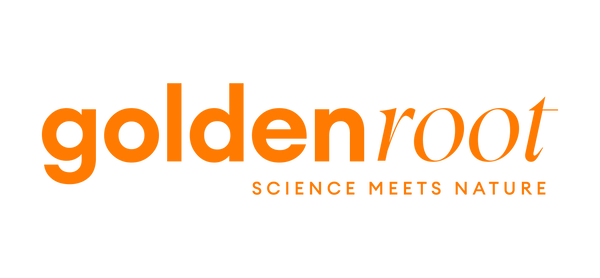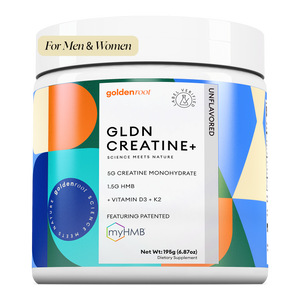A growing body of research shows that HMB (β-hydroxy β-methylbutyrate) can significantly blunt muscle loss during calorie restriction and GLP-1-mediated weight loss by promoting muscle protein synthesis and inhibiting breakdown.
Conversely, GLP-1 receptor agonists (e.g., semaglutide, tirzepatide) effectively reduce fat mass but can also trim lean tissue. Reports show lean-mass reductions ranging from 15% up to 60% of total weight lost.
Integrating HMB (3 g/day), resistance training, adequate protein (1.6-2.2 g/kg/day), and complementary supplements like creatine offers a multifaceted strategy to preserve muscle, optimize fat loss, and even support recomposition while maintaining or gaining muscle on GLP-1 therapy or during dieting.
Related products:
- natural supplements for anxiety and sleep
- creatine and HMB for aging muscle
- berberine for weight loss and metabolism
What is HMB, and How Does it Preserve Muscles?
HMB is a metabolite of leucine that activates mTOR signaling to boost muscle protein synthesis while downregulating proteolytic pathways (ubiquitin-proteasome and autophagy) to prevent breakdown.
Key ways HMB protects muscle:
-
Activates mTOR signaling → boosts muscle protein synthesis
-
Inhibits proteolysis pathways → reduces muscle breakdown
- Enhances fat oxidation → spares muscle as an energy source
HMB for Muscle Retention During Weight Loss
-
Randomized trials report that HMB users lose up to 70% less lean mass during aggressive dieting compared to controls.
- In sedentary overweight adults, 12 weeks of HMB (3 g/day) yielded a 1.8 kg fat-mass reduction with negligible muscle loss.
Read more: Optimizing Protein Intake on GLP-1 Medications: (How Much Do You Really Need)
Is HMB Backed by Science?
Yes, Meta-analyses and position stands affirm HMB’s efficacy across ages and training statuses:
-
Older adults on HMB maintained or improved muscle mass and function over 8-12 weeks.
- Untrained individuals saw reduced exercise-induced damage and enhanced recovery with HMB.
How Do GLP-1 Therapies Affect Muscle?
GLP-1 agonists (e.g., semaglutide, liraglutide, tirzepatide) mimic the incretin hormone to suppress appetite, slow gastric emptying, and improve glycemic control. Their potent anorectic effect drives rapid fat loss.
Muscle loss on GLP-1 therapy:
-
Clinical trials show lean-mass losses constituting 15-60% of total weight reduction on semaglutide and liraglutide.
-
A 2021 network meta-analysis found GLP-1 agonists decreased fat-free mass versus placebo, though results vary by population and protocol.
Bottom line: Without countermeasures, GLP-1 medications can accelerate muscle catabolism, weakening metabolism and functional strength.
Read more: how long does it take for magnesium to work
How to Protect Lean Mass on GLP-1 Medications
The most effective strategy includes:
-
Resistance training (2-3×/week)
- High-protein diet (1.6-2.2 g/kg/day)
-
Targeted supplements — especially HMB and creatine
(GLDN Creatine + HMB) – The Perfect Pair for Muscle Health
GLDN Creatine + HMB is a premium supplement designed to support muscle strength, enhance recovery, and promote bone health.
This advanced formula combines scientifically backed ingredients to help you maintain lean muscle mass, especially during weight loss, aging, or while using GLP-1 medications.
Read more: Creatine: Not Just for Muscles, A Boost for Your Brain Too
What's Inside?
-
Creatine Monohydrate (5g): Boosts muscle energy, strength, and endurance by replenishing ATP stores.
- myHMB® (Patented HMB): Helps prevent muscle breakdown and supports recovery by reducing protein degradation.
-
Vitamin D3 + K2: Enhances calcium absorption and directs it to bones, promoting bone density and joint health.
Why It Works?
This synergistic blend supports muscle preservation, strength, and recovery, making it ideal for individuals undergoing calorie restriction, aging adults, or those on GLP-1 therapies.
Key Benefits
-
Reduces Muscle Loss: Especially during weight loss or aging.
-
Improves Strength and Endurance: Enhances performance during workouts.
-
Supports Bone and Joint Health: With added Vitamin D3 and K2.
- Boosts Recovery and Metabolism: Aids in faster recovery post-exercise.
-
May Enhance Mental Focus: Creatine has been shown to reduce mental fatigue.
How to Take It
-
Dosage: Take 1 scoop (6.5g) daily.
- Mixing: Combine with water, juice, or any beverage of your choice.
-
Flavor: Unflavored for easy addition to your routine.
Read more: What Effect Do GLP-1 Drugs Have on Bone Health and Muscle?
Bonus Points
-
Gluten-Free
-
Dairy-Free
-
Dye-Free
-
Paleo-Friendly
-
Performance Lab®
- Backed by Science
-
60-Day Money-Back Guarantee
Combining HMB with GLP-1: A Practical Strategy
-
HMB (3 g/day): Directly protects muscle proteins.
-
Creatine (3-5 g/day): Fuels anaerobic work and promotes cell volumization.
- Whey protein: Ensures daily protein targets are met.
- Omega-3s & multivitamins: Support recovery and fill micronutrient gaps.
Read more: is creatine safe while breastfeeding
Final Thoughts
Actionable take-home points to consider:
- Implement HMB (3 g/day): Blunts muscle catabolism during weight loss.
- Maintain protein intake: 1.6-2.2 g/kg/day, timed evenly.
- Engage in resistance training: 2-3 sessions/week with progressive overload.
- Stack creatine (3-5 g/day): To boost performance and muscle volume.
- Monitor body composition: Adjust nutrition and training based on lean-mass changes.
You’ll preserve strength and enjoy more sustainable, healthful weight loss by weaving HMB into a comprehensive GLP-1-assisted or caloric-restriction program (bolstering it with protein, creatine, and resistance exercise).
Read more: Vitamin D3 and K2 for Bone Health: Protecting Your Skeleton on GLP-1 Medications




